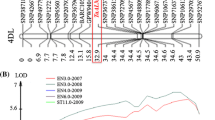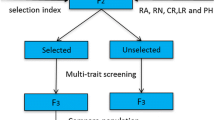Abstract
Manganese deficiency is a major constraint to the growth of cereals on alkaline soils particularly for durum and bread wheat which are generally more intolerant than barley. Genetic variation for manganese efficiency exists in current germplasm of bread wheat and has recently been identified in durum wheat.
Development of a screening technique and a selection criterion has enabled further genetic studies, resulting in a hypothesis that manganese efficiency is controlled by at least two major genes. This has made breeding for manganese efficiency feasible.
The development of the molecular markers for loci conferring Mn efficiency could accelerate the breeding of manganese efficient varieties. To identify markers linked to a locus conferring Mn efficiency, Amplified Fragment Length Polymorphism (AFLP) was combined with Bulked Segregant Analysis (BSA). A total of 176 primer combinations were used to compare the bulk samples the two parents within an inbred population (189 F2’s) derived from a Mn-efficient (Stojocri 2) x Mn-inefficient (Hazar) durum wheat. Twenty pairs of primers revealed at least one polymorphic band between the two contrasting bulks. The segregation of each of these bands was evaluated in 80 F2’s selected from the two extreme ends of the bioassay distribution (40 individuals from each of the Mn-efficient and Mn-inefficient ends). Two AFLP markers showed significant linkage to the Mn efficiency and explained up to 40% and 45% of the genetic variation respectively. Linkage studies showed that these markers were not significantly linked. Cloning, sequencing and conversion of a selected AFLP marker to a PCR based assay is in progress. Studies of the traits in the simpler (durum) genome are well under way and is described below.
In hexaploid wheat screening for potential donors of manganese efficiency to current Australian varieties has been accomplished, Doubled haploid populations have been produced and screened for manganese efficiency, and identification of linked makers has commenced.
Access this chapter
Tax calculation will be finalised at checkout
Purchases are for personal use only
Preview
Unable to display preview. Download preview PDF.
Similar content being viewed by others
References
Attari, EL., Rebai, A., Hayes, P. M., Barrault, G., Dechamp-Guillaume, G., and Sarraffi, A. (1998) Potential of double-haploid line and localisation of quantitative trait loci (QTL) for partial resistance to bacterial leaf streak (Xanthomonas campestris pv. hordei) in barley. Theor. Appl. Genet. 96, 95–100.
Bai, G., Kolb, F. L., Shaner, G., and Domir, L. L. (1999) amplified fragment length polymorphism markers linked to a major quantitative trait locus controlling scab resistance in wheat. Phytopathology 89, 343–348.
Chantachume, Y. (1995) Genetic studies on the tolerance of wheat to high concentration of boron. Ph.D., The University of Adelaide, Adelaide, South Australia.
Graham, R. D. (1988) Genotypic differences in tolerance to manganese deficiency. In Manganese in soils and plants (Edited by R. D. Graham, R. J. Hannam, and N. C. Uren ), pp. 261–276.
Kluwer Academic Publishers, Dordrecht, The Netherlands. Hartl, L., Mohler, V., Zeller, F. J., Hsam, S. L. K., and schweizer, G. (1999)
Identification of AFLP closely linked to the powdery mildew resistance genes Pm lc and Pm 4a in common wheat (Triticum aestivum L.). Genome 42 322–329.
Huang, C., Webb, M. J., and Graham, R. D. (1994) Manganese efficiency is expressed in barley growing in soil system but not in solution culture. J. Plant Nutr. 17, 83–95.
Huang, C., Webb, M. J., Graham, R. D., and Huang, C. Y. (1996) Pot size affects expression of Mn efficiency in barley. Plant Soil 178, 205–208.
Jamjod, S. (1996) Genetic studies on the tolerance of durum wheat to high concentration of boron. Ph.D., The University of Adelaide, Adelaide, South Australia.
Khabaz-Saberi, H., Graham, R. D., Ascher, J. S., and Rathjen, A. J. (2000) Quantification of the confounding effect of seed Mn content in screening for Mn efficiency in durum wheat (Triticum turgidum L. var. durum). J Plant Nutr. 23.
Khabaz-Saberi, H., Graham, R. D., and Rathjen, A. J. (1997). Genotypic variation for manganese efficiency in durum wheat (Triticum turgidum L. var. durum). In (T. Ando, K. Fujita, T. Mae, H. Matsumoto, S. Mori, and J. Sekiya), Kluwer Academic Publishers. Tokyo, Japan. 33–35.
Khabaz-Saberi, H., Graham, R. D., and Rathjen, A. J. (1999) Inheritance of Mn efficiency in durum wheat (Triticum turgidum L. var. durum). J Plant Nutr. 22, 11–22.
Langridge, P. (1994) Molecular markers in wheat breeding and research. In 7th Assembly Wheat Breeding Society of Australia (Edited by J. G. Paull, I. S. Dundas, and K. W. Shepherd ), The University of Adelaide, Adelaide.
Large, E. C. (1954) Growth stages in cereals. Plant Path 3, 128–129.
Manly, K. F., and Cudmore, R. H. Jr. (1997). Map manager QT, Software for mapping quantitative trait loci. In St Petersburg, FL.
Marino, C. L., Nelson, J. C., Lu, Y.H., Sorrells, M. E., Leroy, P., Tuleen, N. A., Lopes, C. R., and Hart, G. E. (1996) Molecular genetic maps of the group 6 chromosomes of hexaploid wheat (Triticum aestivum L. em. Thell). Genome 39, 36–369.
Mather, K., and Jinks, J. L. (1977) Introduction to biometrical genetics. London, UK.: Chapman and Hall London, UK.
Michelmore, R. W., Paran, I., and Kesseli, R. V. (1991) Identification of markers linked to disease-resistance genes by bulked segregant analysis: A rapid method to detect markers in specific genomic regions by using segregating populations. Proc. Natl. Acad. Sci. USA. 88, 9828–9832.
Robson, A. D., and Snowball, K. (1986) Nutrient deficiency and toxicity symptoms. In Plant analysis-An interpretation manual (Edited by D. J. Reuter, and J. B. Robinson ), pp. 13–19. Inkata press, Melborne.
Rogowsky, P. M., Guidet, F. L. Y., Langridge, P., Shepherd, K. W., and Koebner, R. M. D. (1991) Isolation and characterisation of wheat-rye recombinants involving chromosome arm 1DS of wheat. Theor Appl Genet 93, 19–198.
Viccars, L., Spindler, L., Hook, I., Wildermuth, G. B., Thompson, J. P., Banks, P. M., Appels, R., and Lagudah, E. S. (1999). Genetic markers for resistance to crown rot and root lesion nematode in wheat. In (P. Williamson, P. Bank, I. Haak, J. Thompson, and A. Campbell), The University of Southern Queensland, Toowoomba, Australia.
Vos, P., Hogers, R., Bleeker, M., Reijans, M., Lee, T. V. D., Hornes, M., Frijters, A., Pot, J., Peleman, J., Kuiper, M., and Zabeau, M. (1995) AFLP: A new technique for DNA fingerprinting. Nucleic Acids Res. 23, 4407–4414.
Williams, K. J., Fisher, J. M., and Langridge, P. (1994) Identification of RFLP markers linked to the cereal cyst nematode resistance gene in wheat. Theor. Appl. Genet. 89, 927–930.
Author information
Authors and Affiliations
Editor information
Editors and Affiliations
Rights and permissions
Copyright information
© 2001 Springer Science+Business Media Dordrecht
About this chapter
Cite this chapter
Khabaz-Saberi, H., Graham, R.D., Rathjen, A.J., Williams, K.J. (2001). Breeding for Manganese Efficiency in Durum Wheat. In: Bedö, Z., Láng, L. (eds) Wheat in a Global Environment. Developments in Plant Breeding, vol 9. Springer, Dordrecht. https://doi.org/10.1007/978-94-017-3674-9_78
Download citation
DOI: https://doi.org/10.1007/978-94-017-3674-9_78
Publisher Name: Springer, Dordrecht
Print ISBN: 978-90-481-5618-4
Online ISBN: 978-94-017-3674-9
eBook Packages: Springer Book Archive




